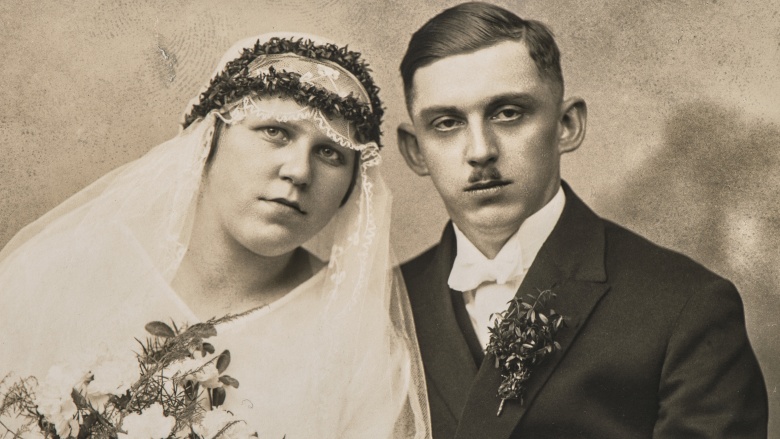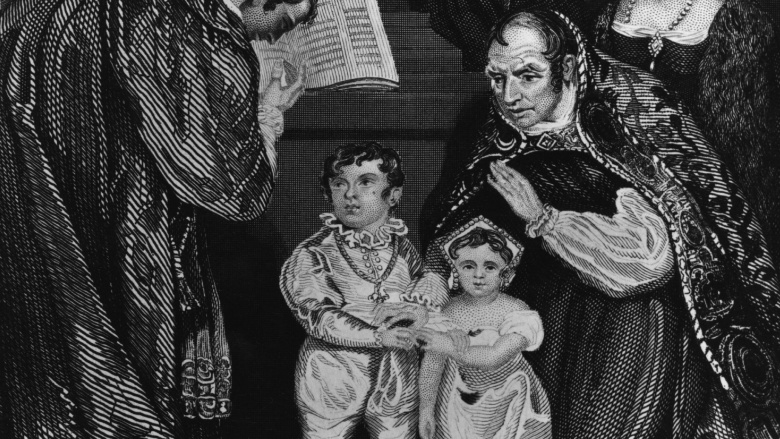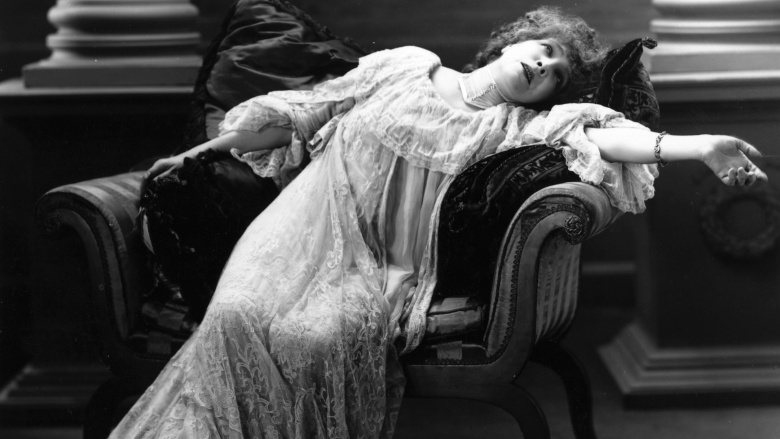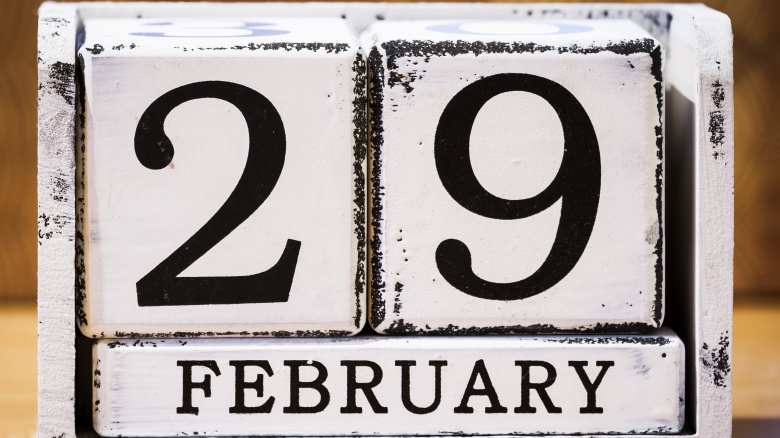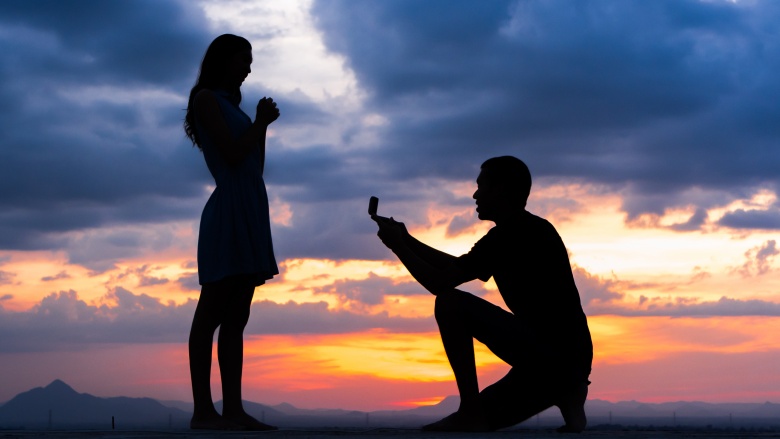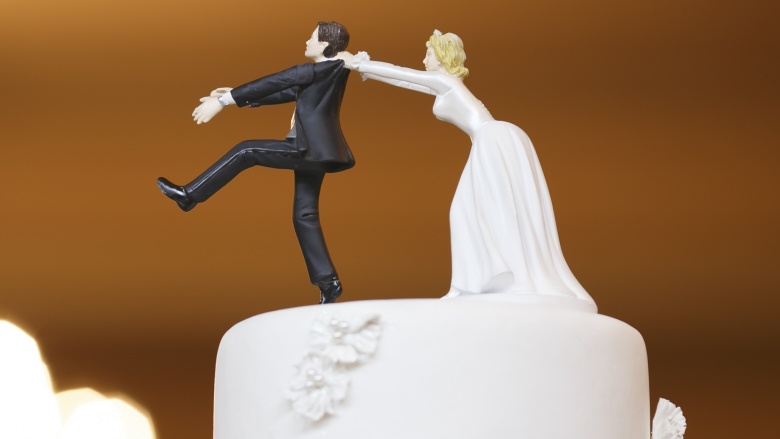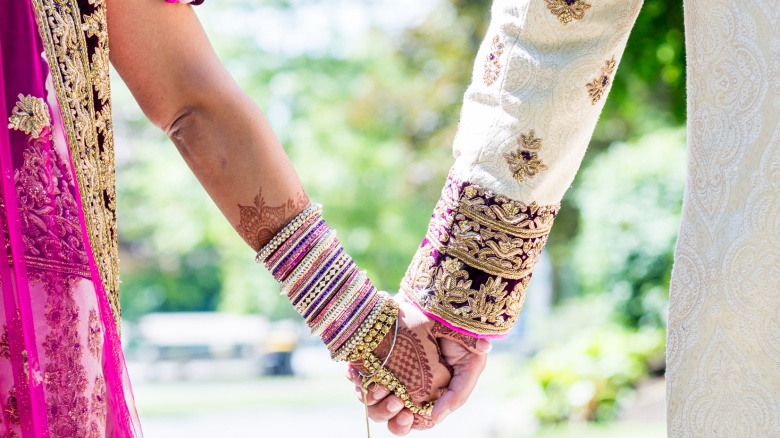Why Men Historically Propose To Women
My best friend and I have known each other, and been best friends, since first grade. Although we're more like sisters at this point, we're also very different — and, interestingly, one of the ways this played out was how we each got engaged.
My husband and I went a more traditional route, in that he was the one who popped the question. Granted, I knew it was coming. He and I had talked about it in detail, laid out our requirements for circumstances that had to be met before we'd be comfortable getting engaged, and, once those requirements were met, designed the ring together.
And, when he got down on his knee and busted out the ring, I replied with a much less traditional "[expletive] yes, I'll marry you," followed by a "stand the [expletive] up, dude, this is a marriage of equals and you don't need to kneel!" So there's one break with tradition, in that my very sweary acceptance isn't how, well, pretty much any women of yore would've responded.
My bestie, by contrast, decided she wanted to be the one to propose to her then-boyfriend (who's now her husband and is an all-around awesome dude). I was surprised when she told me her plan, only because I'd never known anyone who'd flipped the traditional gender roles like that — but about .06 seconds later, I though, 'Who says the man has to be the one proposing?' I mean, just because something has, in recent memory, always been done a certain way, that doesn't rule out doing it differently now.
And, for that matter, why don't women propose? Why has it always been done this way? What's the history behind men as the ones giving the proposal and women as the ones receiving it?
The history of marriage
In order to understand why men propose to women, it's important to get a sense of how marriage itself evolved. Or, to quote The Princess Bride, "Mawwage. That bwessed event, that dweem wivin a dweem!"
Marriage began, back in the Stone Age, as a means of building alliances, as well as organizing disparate groups people, the land they worked, and the goods they produced. "Marriage spoke to the needs of the larger group. It converted strangers into relatives and extended cooperative relations beyond the immediate family or small band by creating far-flung networks of in-laws," explains author Stephanie Coontz in Marriage, a History. Eventually, "as civilizations got more complex and stratified, the role of marriage in acquiring in-laws changed...marriage was an economic and political transaction," and as a result, "finding a husband was usually the most important investment a woman could make in her economic future," Coontz writes.
This system of marriage as a means of economic and political advancement was nearly universal until about the late eighteenth century, when social norms started to shift towards people choosing their spouses based on love and personal affection rather than political or economic expediency. And y'all, this was a radical change, which many thought was irrational and would almost certainly end in disaster.
By the nineteenth century, "Most Europeans and Americans came to accept a new view of husbands as providers and of wives as nurturing homemakers," explains Coontz.
So, now knowing the backgwound of maww — er, I'm sorry, the background of marriage itself, how does the proposal play into this?
Women and girls as property (or, "God, this is depressing")
So, let's cut to the chase of the most unpleasant part of this discussion — the fact that until very recently, for almost the entire time that the concept of marriage has existed, women have been treated as property. Back in the days of marriage as a transaction, the families of the people getting married would negotiate a deal, and the bride was a key part of that transaction. Women would be traded from one family to another in exchange for land, offers of protection, or to secure her family's social position. In other cases, women were married off as a means of settling or paying a debt.
While we're discussing depressing things, we should also address an especially awful aspect of this whole "women as property" scenario, which is that in many cases, the brides weren't women — they were often girls or young teenagers. For example, ancient English king Henry III married his wife, Eleanor of Provence, when he was 28 and she was 12.
Because women had almost no say in whether or not they got married (let alone to whom) the men were, indisputably, the ones who sought marriage.
Women were too emotional to choose
Around the time people started to marry for love rather than collective benefit, about the late 1700s, there was the delicate matter of whether women would be able to choose their own mate.
The answer was no.
Women had long been considered too emotional and irrational to be trusted to select a good husband, and that mindset continued to inform how love marriages evolved. Because men supposedly had more to lose by getting married, they were considered to be the more rational, level-headed decision makers. And so, they remained the ones driving the proverbial love train, and the tradition of men being the ones to propose continued.
Leap Year is more than a rom-com
The lone exception to the ban on women-led proposals occurs on Leap Day — when, according to Irish legend, St. Brigit of Kildare supposedly brokered a deal with St. Patrick in which women were allowed to propose to men, but only on February 29. This was supposedly done in an effort to balance out traditional gender roles (St. Brigit, props for your proto-feminism!), and thus, although it would be rarely practiced, the tradition of Leap Day proposals was born. (And, hence, the Amy Adams movie.)
However, it brought with it an ugly practice — Leap Year proposals were relentlessly ridiculed and mocked. Women who proposed were portrayed as ugly, aggressive, and desperate — so much so, in fact, that Leap Day illustrations from 1900 depict men going to any means necessary to avoid such threats of marriage. (Think men hiding in trees while women sporting elongated, witch-like noses go marauding with lassos. Charming.)
Men as the provider (or, "what a guy, that Gaston!")
Thankfully, people eventually moved away from the idea that women were property to be bought, sold, or traded. Along with the rise of love marriages, came the idea that men are the providers and women are the nurturers and beneficiaries of the men's work. This became most evident during the 1950s, when marriage was considered to be the best gift a young woman could be offered — it was, at the time, seen as her best opportunity to find dignity and purpose.
In fact, men were often encouraged to see themselves as women's rescuers, since according to Phillip Roth, author of My Life as a Man, "unattached and on her own, a woman was supposedly not even able to go to the movies or out to a restaurant by herself, let alone perform an appendectomy or drive a truck.". Young men were taught it was up to them to "give [women] the value and the purpose that society at large withheld — by marrying them."
Additionally, because men were expected to provide for their wives, proposals were often timed according to when men were financially ready for marriage, not when the bride was. In their role as a provider, the man clearly held the reins when it came to proposing.
A tradition remains strong
Obviously, a lot has changed since the 1950s, but the idea that a man should be the one to propose has proven to be remarkably resistant to change. "A man asking a woman to wed is a ritual that's very powerful...having him ask for her hand in marriage is a way of signaling to her, and his friends and family, that's he's serious and ready for a future with her," says Bradford Wilcox, professor of sociology and director of the National Marriage Project at the University of Virginia.
There's speculation that, just as back in the day when the man was expected to provide for his wife, proposals have taken on new significance in the era of dual-income marriages. "Her fear might be that if she asks and he says yes, he's just going along to get along...getting that formal proposal from him is one way of addressing that concern," Wilcox says.
The hard part of modern marriage
This can lead to a sticky situation, which has become a pop culture trope: she loves him, is emotionally expressive, and wants to get married, but he struggles to articulate his emotions and equivocates on the matter of lifelong commitment. So, the trope goes, she drops hints, nags, and tries to convince him to propose.
Basically, it's like a Chipotle burrito of mixed messages, all wrapped up in a nice warm tortilla. (The guac will cost extra, but think of it like pre-marital counseling: it's awesome and everyone benefits, so it's worth the investment.)
On one hand, the cultural pressure for a woman not to propose is strong, even though other societal norms are radically shifting. And on the other hand, as Chicago-based couples counselor Julienne Derichs notes, "even though most of the legal and economic basis for a husband's dominion over this wife and her deferring to his needs is gone, there are passed down unconscious habits and emotional expectations that preserve a woman's disadvantage in marriage. A man being solely responsible for proposing is an unnecessary and antiquated norm."
Proposals: What to do?
So, then, what's a woman to do when she knows she's ready to get married?
The best thing you can do is to talk about it. Make sure you and your significant other are on the same page, and don't shut down if it turns out you're not. It may be that he needs time and will get there eventually — or it may be that having this conversation helps you dodge a bullet by finding out now, not after he's grudgingly proposed, that he's not the right guy for you. (Speaking from personal experience on this one, I can say that while it's miserable in the short term, it's much, much better in the long term. I was unceremoniously dumped after a conversation like this, and although I was devastated at the time, I'm unspeakably relieved and grateful now.)
Additionally, according to Derichs, "Two people who are entering into a marriage need to make that decision together, equally, and this helps to create a solid foundation for a long term commitment." If you feel strongly that you want your boyfriend to propose, making sure there's been enough dialogue about getting married, his plans to propose, etc. can help ensure that you're going into this on equal footing. Knowing that it's coming — so that it's a tactical surprise, but not a strategic one — is a big step forward, as well.
Ultimately, though, women have the power to change this millennia-old narrative. For some women like my bestie, that'll involve taking the reins on marriage proposals. (Fun side fact: she gave him a donut instead of a ring, and the pictures are amazing.) For other women, it'll entail working with boyfriends and partners to discuss the idea of engagement, and even to craft a proposal that both parties are comfortable with.
Eventually, brides (the women who were once traded for cattle, or considered too emotionally volatile to choose their own husbands) will be able to turn this age-old, one-way custom on its head.

